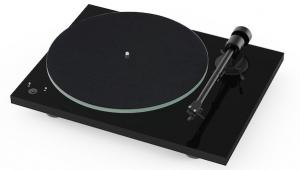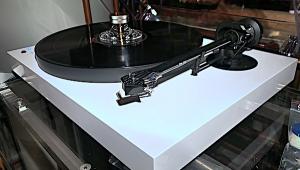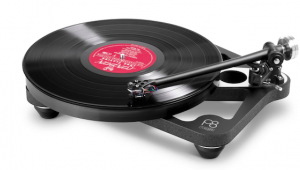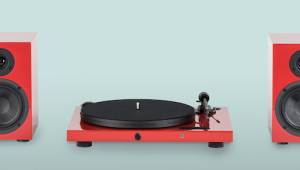Windows 11 further deepens the user’s experience with a full range of exclusive and refined features designed to simplify, protect, and enhance daily tasks for this page . With activation, personalization settings are completely unlocked, allowing users to tailor everything from the Start menu layout and taskbar configuration to accent colors, wallpaper, and even the way notifications are displayed. This freedom to adjust Windows 11 to fit specific needs and preferences creates a user-friendly environment that feels truly individualized.
Wilson Benesch Full Circle turntable, ACT 0.5 tonearm, & Ply MC cartridge Page 3
Why take the music apart? The Full Circle didn't. It was impressively coherent from top to bottom, with an overall tonal neutrality and rhythmic certainty that made listening long into the night both easy and pleasurable. The presentation offered not a hint of grain or brightness, and the critical midband was rich, airy, and lush. Speed accuracy was dead on.
On a clean Living Stereo pressing of Tschaikowsky's (sic "vintage" RCA spelling) Violin Concerto with Heifetz and Reiner/CSO (LSC-2129), the Full Circle presented the liquid, well-focused violin well in front of the orchestra, neither softening nor exaggerating the rasp of the bow sliding across the strings.
As Heifetz played through his instrument's mid-upper register, the Full Circle never sounded etched, aggressive, or steely. Yet it never sounded dull or soft either. It just sounded uncolored and essentially correct, if just slightly laid-back—which is the worst that can be said for the Full Circle's overall sonic performance. Some may wish for more "sparkle" and edge, but I'm not sure that would be more accurate. In fact, I was struck by how vivid and convincing the violin sounded, and how close it was in some ways to the real thing, which I'd heard at Tanglewood a few weeks earlier.
As you might expect from such tonal and transient performance, the Full Circle created a plush, airy soundstage that never adhered to the baffle fronts. Focused, three-dimensional images developed well behind the speakers, as they do with far more expensive arm/'table combinations. Edge definition—the demarcation between image and surrounding space—was impressively natural, unmarred by the sharp, cookie-cutter distinctions common among inexpensive 'tables.
Inevitably, though, the seams show on a product built to a price point, and while the Full Circle's were difficult to spot, they were audible. When compared to far more expensive competition, the arm/'table combo's three biggest shortcomings were: somewhat compressed macro- and microdynamics, which limited explosiveness on one end of the scale and diminished the resolution and "liveness" of inner detail on the other; a higher noise floor, with more of a sense of a "milky" background and less of a sense of "black" behind the music; and a bit of soundstage congestion that pressed images together.
But these were all minor sins of omission in what was, really, an impressively natural-sounding overall performance. And there are two things you can do to improve the sound. One is to use the cork-and-paper Ringmat 330, which for some reason increases the "blackness" between notes, and tightens and better defines the bass. But check your VTA—the cork ridges raise the front of the arm.
The other is to plug the Circle's motor into the $300 VansEvers Clean Line Jr. turntable line-conditioner, which includes a pair of impedance shifting switches, the effects of which were easily audible. Just plugging the 'table into the unit seemed to relieve some of the congestion, but flipping the switches back and forth had a profound effect on transient speed and rhythmic pace. If you want a bit more shimmer to cymbals and crack to snare drum, flip the switches to "2" and "4." Want a more relaxed sound? Flip them to "1" and "3." I couldn't get this effect with the Yorke 'table, so I figure it's more audible with lower-mass platters (the Yorke's weighs in at 24 lbs). As VansEvers offers a money-back guarantee if you don't hear a difference, it's worth checking out.
Ply sound
Once I'd finished with the Temper, the Clavis D.C., and a few other high-priced cartridges, I returned to the Ply and let it break in again. The Ply is a reasonably accomplished cartridge, as is the Benz-Micro Glider, on which it's based (footnote 1). As you might expect, it lacked the dynamic slam, harmonic vividness, and inner-detail resolution of the more expensive cartridges, but it was evenhanded in what it gives up to cartridges costing two, three, and four times as much. It was an extremely smooth-sounding transducer, and didn't do anything particularly wrong—especially in terms of brightness, edge, and/or grain, of which it exhibited none. Plus, it has a reasonably high output. But is it worth $150 more than a standard high-output Glider? I can't answer that for you because I haven't auditioned the Glider in familiar surroundings. In any case, it proved a nice match for the Full Circle, though the arm/'table is capable of even finer performance.
The Competition
Manufacturers hate comparisons. Readers love them. Guess who wins?
At $2995 without cartridge, the Full Circle's most obvious competition is the similarly priced Rega Planar 9, which I reviewed last year (Stereophile, August 1997, Vol.20 No.8). Though I no longer have the Rega on hand for a side-by-side comparison, the two 'tables make an interesting study in contrasts: one is a budget model from a maker of expensive turntables, the other a "statement" product from a manufacturer known for inexpensive designs.
Rega chose to upgrade from its standard glass platter to a hi-tech platter made (in conjunction with a manufacturer of missile nose cones) of ceramic oxide powder that is first compressed, then fired at 3000°C. It's extremely hard, perfectly balanced, and lively. W-B chose to save money with an acrylic platter in place of the heavy aluminum one used on its expensive 'table.
Rega upgraded from its simple motor/wall-socket power-supply drive to a sophisticated 24V twin-phase synchronous motor with an extremely sophisticated outboard power supply that feeds the two phases independently and cancels out motor vibration. According to Rega, the motor can thus be mounted directly to the plinth, which is a thin, light laminate of chipboard and phenolic plastic.
W-B went with a simple power supply to feed its AC-synchronous motor, but took great pains to design a sophisticated (though simple to set up) isolation system using two plinths and a series of platforms supported by carbon-fiber tubes.
Rega chose to upgrade its classic cast RB300 arm, which allows for no VTA or azimuth adjustment but, via ultra-high-quality ball/race bearings used in navigational gyroscopes, offers the cartridge a supremely rigid and accurate ride. W-B offers buyers what is a very close replica of its ultrasophisticated, groundbreaking, carbon-fiber Kinematic bearing in a completely adjustable arm.
You know something? You've got to love the fact that, at this late date, these folks care so much and work so hard to try to solve the intractable problems of analog playback. And they both do it really well, and at reasonable prices.
Which is "better"? I can't answer that. From my recollection of the Rega, it sounds more lively, "fast," and exciting. The W-B is richer, airier, somewhat smoother, more neutral and laid-back, and easier to listen to for long periods. I also think it has better bass extension, but too much has changed in my system to be sure.
In any case, these are two really accomplished products. If I were in the market for a 'table priced at around $3000, I'd be sure to audition both. But you won't go wrong with either.
Conclusion
The Full Circle turntable/ACT 0.5 tonearm combination is a compact, innovative, attractive, and extremely well-made analog playback system. It's easy to use, and easy to optimize for any cartridge. It offers exceptional low-bass extension and focus without sacrificing anything above. The mids are pure and sweet, and the top end is airy, extended, and well focused, without a trace of brightness and/or edge. Speed accuracy is outstanding. The Full Circle's overall performance is impressively neutral and rich.
Some listeners might prefer more rhythmic "snap" and transient excitement, but I'm not sure that would render the music any more accurately. Clearly, the Full Circle was designed and built by people who listen to and love music.
The Ply cartridge, like its progenitor, the Glider, is a smooth, sophisticated performer that shaves a little here, cuts a little there, and ends up giving you a high percentage of what you get from the best cartridges. It's a good match for the Full Circle, though the arm/'table combo is worthy of the best cartridges you can throw at it. The Full Circle's performance can be subtly enhanced with the Ringmat and the VansEvers Analog Jr. power-line conditioner, but, even straight out of the box, this turntable ends up in the winner's circle, and is a very good value for the money.
Footnote 1: The Glider was reviewed for Stereophile by Lonnie Brownell in August 1996 (Vol.19 No.8)
- Log in or register to post comments





















































